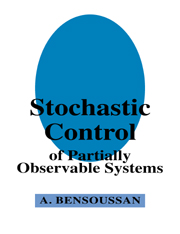The problem of stochastic control of partially observable systems plays an important role in many applications. All real problems are in fact of this type, and deterministic control as well as stochastic control with full observation can only be approximations of the real world. This justifies the importance of having a theory as complete as possible, which can be used for numerical implementation.
In the first three chapters of this book we study problems which can be dealt with directly by algebraic manipulations, without using the complete theory. This is because the system and the observation have linear dynamics, and the cost is either quadratic or the exponential of a quadratic functional.
In Chapters 4 to 6, we present the theory of non linear filtering, which is the basic step in formulating the control problem adequately. The main difficulty, especially from the point of view of numerical applications, is that there are no statistics which are finite dimensional, and the basic object to be computed is the conditional probability. This is the solution of a stochastic partial differential equation (PDE) studied in Chapter 4. Chapters 5 and 6 are devoted to approximations, when perturbation methods are applicable, or to particular cases when simplification occurs, and sufficient statistics exist.
In Chapter 7, we study stochastic control problems with partial information, in an intermediate case, namely when the direct methods of Chapters 1, 2, 3 are not applicable yet the full theory is not necessary, either because finite dimensional sufficient statistics are available, or approximations are possible.
